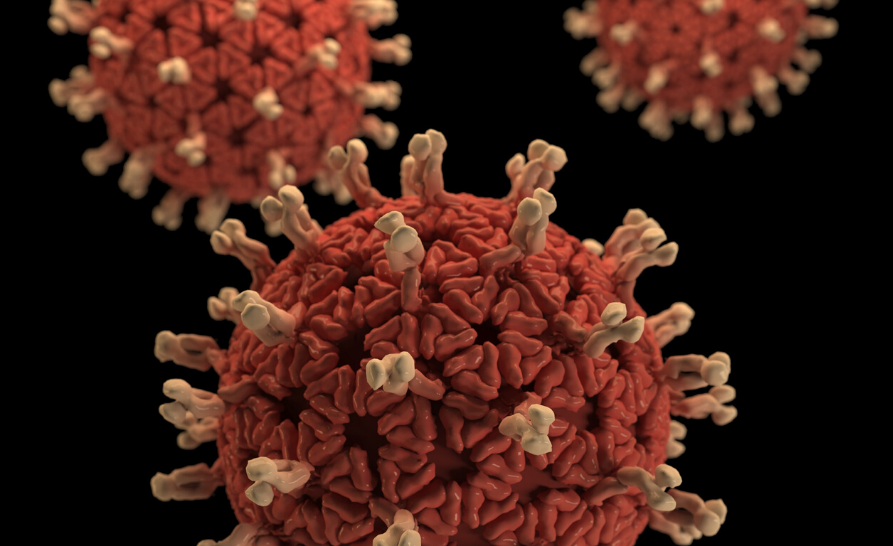Artificial Intelligence helps to estimate how many beds are needed in the pandemic
In March 2020, the World Health Organization (WHO) declared the Covid-19 pandemic, a disease caused by SARS-Cov-2. Virus infection results in a syndrome that leads, in some cases, to an intensive care respiratory condition, which often requires specialized management in intensive care units (ICUs). With the help of Artificial Intelligence (AI) and a multidisciplinary team, professor at the PUCRS School of Medicine and researcher at the Brain Institute of Rio Grande do Sul (InsCer), Bruno Hochhegger is developing a method that should estimate the number of beds needed for patients with the disease.
Similar to other viral respiratory pathogens, the new coronavirus has, in most cases, a rapidly progressive course of fever, cough and shortness of breath, in addition to leukopenia and severe acute respiratory syndrome, which were already health threatening factors. public. “AI algorithms, in particular deep learning, have shown remarkable progress with traditional algorithms and have shown attractive performance in relation to the classification of lung diseases,” explains Hochhegger.
Technology for a healthier future
In response to the pandemic, hospitals must understand their ability to care for patients with serious illnesses, such as acute respiratory syndrome, explains the researcher. Through the use of AI in the evaluation of CT scans of patients, it is possible to provide a robust projection for the health system as a whole on bed occupancy. In addition, early evaluation and prognosis contribute to the search for potential treatments and courses of the disease.
In response to the pandemic, hospitals must understand their ability to care for patients with serious illnesses, such as acute respiratory syndrome, explains the researcher. Through the use of AI in the evaluation of CT scans of patients, it is possible to provide a robust projection for the health system as a whole on bed occupancy. In addition, early evaluation and prognosis contribute to the search for potential treatments and courses of the disease.
About the research
With the aid of AI applied to computed tomography of the chest, based on the evolution of the disease, the team of researchers is able to obtain more complete answers. Very complex parameters are used to help estimate the number of beds needed for the treatment of patients.
With the aid of AI applied to computed tomography of the chest, based on the evolution of the disease, the team of researchers is able to obtain more complete answers. Very complex parameters are used to help estimate the number of beds needed for the treatment of patients.
Check out the main objectives:
Assess the factors involving mortality, hospitalizations and pulmonary sequelae in patients;
Evaluate the accuracy (proximity of a result to its real reference value) and the prevalence of AI algorithms for detecting chest radiographic findings;
Characterize patients suspected or confirmed with Covid-19 through molecular assay;
Analyze clinical signs and symptoms in patients suspected or confirmed for Covid-19 infection;
Identify the number of people infected;
Identify patterns or imaging changes (diagnostic imaging) of patients;
Identify possible relationships between clinical findings and imaging tests with the age of patients;
And evaluate the evolution of the clinical and imaging condition of patients.
Evaluate the accuracy (proximity of a result to its real reference value) and the prevalence of AI algorithms for detecting chest radiographic findings;
Characterize patients suspected or confirmed with Covid-19 through molecular assay;
Analyze clinical signs and symptoms in patients suspected or confirmed for Covid-19 infection;
Identify the number of people infected;
Identify patterns or imaging changes (diagnostic imaging) of patients;
Identify possible relationships between clinical findings and imaging tests with the age of patients;
And evaluate the evolution of the clinical and imaging condition of patients.
The study has a retrospective focus. Through the verification of the electronic medical record, care provided at Hospital São Lucas da PUCRS (HSL) and at other hospitals in the country will be included. Computed tomography images will also be reviewed, as well as patient history, including vaccines, personal history , family history and lifestyle habits.
Covid-19's mortality in numbers
“A recent study carried out by Imperial College in London and signed by 50 of the greatest authorities in infectious diseases and epidemiology in the world indicated catastrophic estimates in relation to the mortality of Covid-19”, highlights Bruno Hochhegger. According to the publication, which analyzed the impact of the disease in 202 countries, if no measures are taken to control the disease, there will be a total of seven billion infected and 40 million deaths worldwide by the end of 2020. span>
“A recent study carried out by Imperial College in London and signed by 50 of the greatest authorities in infectious diseases and epidemiology in the world indicated catastrophic estimates in relation to the mortality of Covid-19”, highlights Bruno Hochhegger. According to the publication, which analyzed the impact of the disease in 202 countries, if no measures are taken to control the disease, there will be a total of seven billion infected and 40 million deaths worldwide by the end of 2020. span>
According to the scientists' projection, if rigorous disease control measures are implemented (large-scale diagnostic tests, social distance, among others), mortality can be reduced by up to 95%, explains the researcher. However, if there is no intervention, 1.15 million Brazilians are expected to die, dropping to 44.2 thousand with the implementation of strict suppression.
Hochhegger warns that, even with active control measures, the disease will cause a collapse in the World Health System, especially in underdeveloped countries, where there is a shortage of resources for health.
About Covid-19
Severe acute respiratory syndrome (SARS) was first recognized as a global threat in mid-March 2003. At that time, the epidemic caused significant social and economic disruption in areas with sustained local SARS transmission. and in the travel industry internationally, in addition to the direct impact on health services.
Severe acute respiratory syndrome (SARS) was first recognized as a global threat in mid-March 2003. At that time, the epidemic caused significant social and economic disruption in areas with sustained local SARS transmission. and in the travel industry internationally, in addition to the direct impact on health services.
About the researcher
In addition to being a professor of Diagnostic Imaging at the School of Medicine at PUCRS, Bruno Hochhegger is a medical coordinator at the HSL Image Center and the Molecular Image Center at the Brain Institute of Rio Grande do Sul (InsCer). He is a member of the European Respiratory Society, American Roentgen Ray Society, Radiological Society of North America and the Gaucho Society of Radiology.
In addition to being a professor of Diagnostic Imaging at the School of Medicine at PUCRS, Bruno Hochhegger is a medical coordinator at the HSL Image Center and the Molecular Image Center at the Brain Institute of Rio Grande do Sul (InsCer). He is a member of the European Respiratory Society, American Roentgen Ray Society, Radiological Society of North America and the Gaucho Society of Radiology.
A multidisciplinary team
Participating in the research: Jaderson Costa da Costa, Fabiano Ramos, Graciane Radaelli, Gabriele Carra Forte, Denise Cantareli Machado, Fernanda Majolo, Gabriele Goulart Zanirati, Nathalia Bianchini Esper, Moraes Cadaval Junior, Gutierre Oliveira, Marcio Sarroglia Pinho, Rodrigo Coelho Barros, Rafael Heitor Bordini, Felipe Rech Meneguzzi, Duncan Dubugras Alcoba Ruiz, Isabel Harb Manssour, Renata Vieira and Andressa Barros.
Participating in the research: Jaderson Costa da Costa, Fabiano Ramos, Graciane Radaelli, Gabriele Carra Forte, Denise Cantareli Machado, Fernanda Majolo, Gabriele Goulart Zanirati, Nathalia Bianchini Esper, Moraes Cadaval Junior, Gutierre Oliveira, Marcio Sarroglia Pinho, Rodrigo Coelho Barros, Rafael Heitor Bordini, Felipe Rech Meneguzzi, Duncan Dubugras Alcoba Ruiz, Isabel Harb Manssour, Renata Vieira and Andressa Barros.


